Your 9-Step Checklist for a Fast, Seamless Snowflake Migration
Migration to a new data platform can be a complex and time-consuming process. A well-defined plan and a checklist are essential in ensuring your migration is successful. In this blog, I’ll outline Pythian’s Snowflake Migration Checklist—a process we’ve refined from our experience helping customers migrate their workloads to Snowflake (a cloud-based data warehousing and analytics platform offering scalability, reliability, security and performance.)
Snowflake Migration Checklist
We have broken our Snowflake Migration Checklist into nine phases to help plan and execute an end-to-end migration of the existing traditional data platform to Snowflake. These phases will help align migration resources and efforts; however, this doesn’t necessarily mean that all steps should be executed sequentially. Some phases, like “Train Users,” can be executed parallel to other phases.
In the following section, we will elaborate on these phases and the tasks you might take for each. Let’s get started.
1. Define your migration goals
Before starting the migration process, it is essential to define the goals and objectives of the migration. This includes identifying the key drivers for the migration, such as cost reduction, improved performance, scalability or enhanced security.
These migration goals can be further subdivided into business and technical goals. Business goals typically focus on achieving business outcomes and improving the bottom line, while technical goals focus on improving the technical capabilities of the migrated platform. Evaluate what you are trying to accomplish, and sit with your key stakeholders to jot these down. These goals should be specific, measurable, achievable, relevant, and time-bound (SMART) and should be communicated to all stakeholders directly or indirectly impacted by the migration. Some general migration goals have been outlined as a reference to get you started:
Business goals
| # | Factor | Description | Measure |
| 1. | Reduce Costs | Reduce costs associated with maintaining legacy systems, such as hardware, licensing and maintenance. | TCO analysis report. |
| 2. | Increase Revenue | Enable new business models, discover and open up new markets or improve sales and marketing effectiveness. | Sales Data Analysis, Customer Acquisition and Retention, Return on Investment (ROI), etc. |
| 3. | Improved Agility | Improve organizational agility by reducing time-to-market, increasing the speed of delivery and enabling faster decision-making. | Resource Utilization Report, Agile Development Metrics, Time-to-Market Analysis, etc. |
| – | – | – | – |
Technical goals
| # | Factor | Description | Measure |
| 1. | Improved Scalability | Improve scalability by enabling the system to handle increasing workloads or data sources, traffic or data volumes. | Performance Metrics, System Availability, Workload Management report, etc. |
| 2. | Enhanced Security | Improve security by implementing modern security practices like encryption, access controls and monitoring capabilities. | Security benchmark reports, security assessments, access management metrics, etc. |
| 3. | Improved Data Management | Improve data management capabilities by implementing modern data warehousing, analytics and reporting technologies. | Data Quality, Data Integration, Data Governance, etc. |
| – | – | – | – |
2. Assess your current environment
As a next step, you will need to thoroughly assess your existing data environment to identify the scope and complexity of the migration. This includes understanding your data sources, types, volumes, and any dependencies between data sources. This may involve but not be limited to the following items to consider:
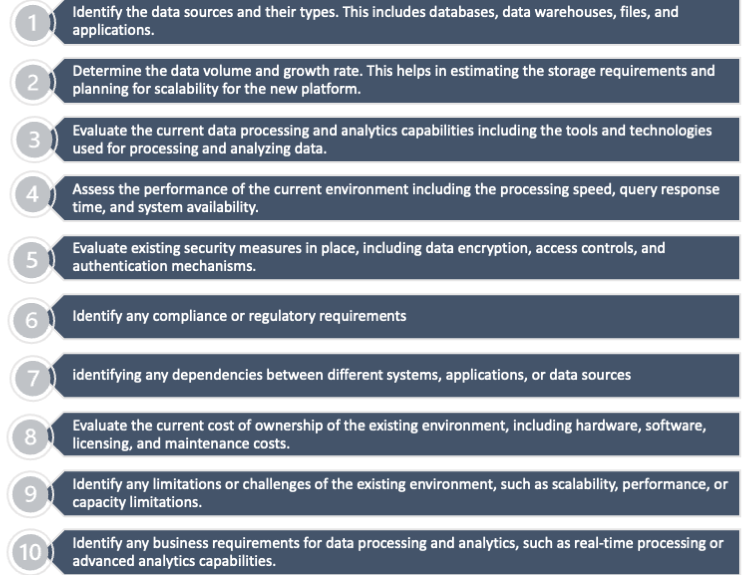
By going through these listed pointers, you can comprehensively understand your existing environment and identify areas that need improvement or optimization. This information can then be used to plan for capacity planning and designing a migration strategy for your new data platform.
3. Plan for Snowflake implementation
The artifacts of discovery and assessment will now contribute to developing a detailed plan for implementing Snowflake. This includes determining the best architecture for your data, configuring the data warehouse, and planning for data ingestion and processing. Use the reference architecture below to design your data platform’s use case.
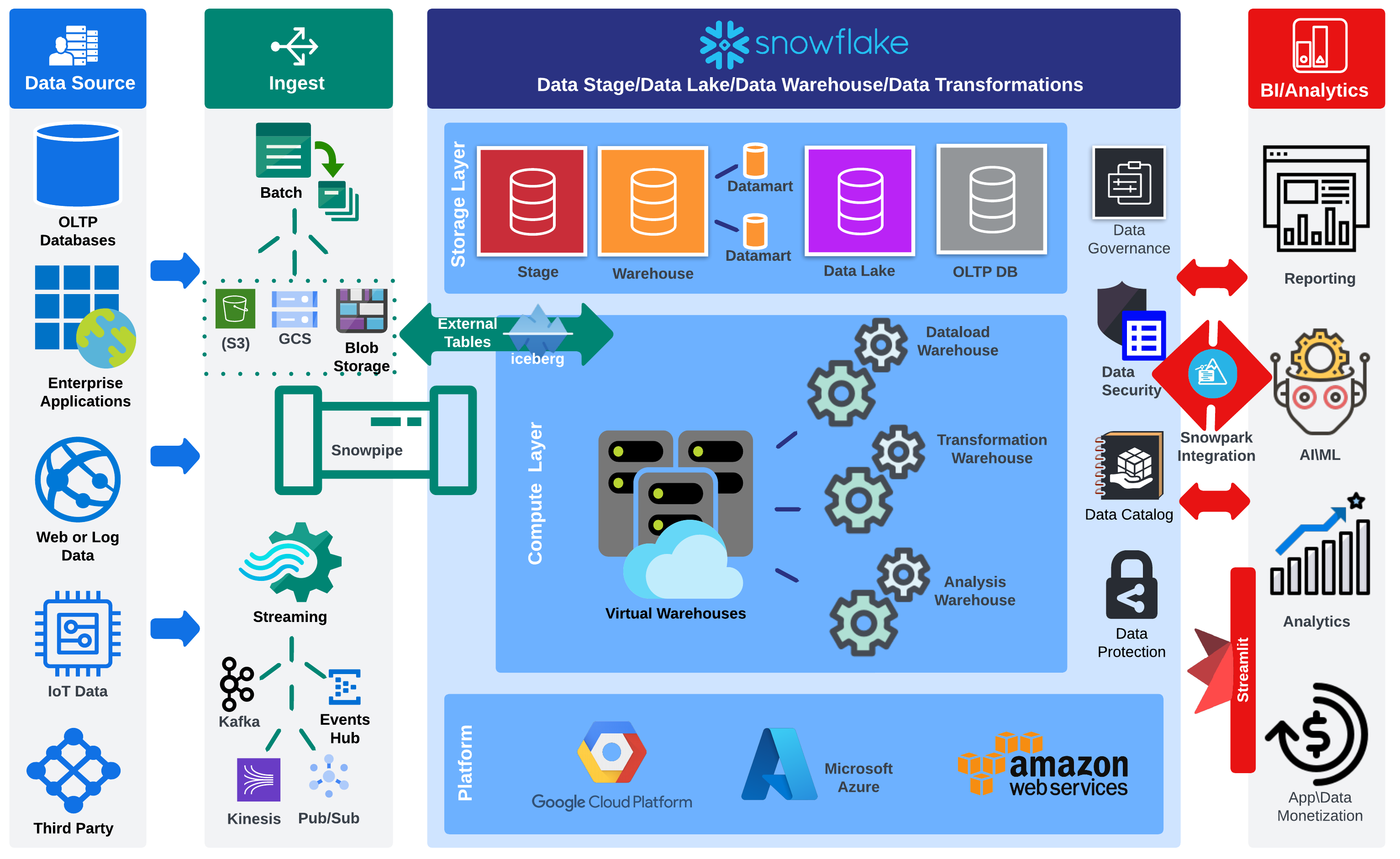
At this point, having a requirement guide would help align the implementation goals. Start with some of the below and adjust as necessary:

The requirements will help answer initial deployment questions for Snowflake, like, which region to choose, what edition to go with, etc. In addition, this will also help you gain a better understanding of the requirements around security posture, developer ergonomics and ongoing support. After this phase, you should either have a Snowflake platform ready for migration or a templated code base that can deploy a Snowflake environment reflecting your requirements in a source-controlled, repeatable and template-driven manner.
To build the Snowflake environment using Terraform, then leverage Snowflake Provider. Pythian internally wrote a best practice document mentioning the base configuration of Snowflake for customers’ deployments and built a template-driven code base using Terraform to deploy the same. If you’re looking to fast-track your base implementation of Snowflake, reach out today; we can help accelerate your migration goals.
4. Define your migration strategy
Based on the assessment of your current environment and Snowflake implementation plan, you would next need to define a migration strategy. This includes identifying the data to be migrated, selecting the migration tools and processes and developing a timeline for the migration. There are several migration strategies for Snowflake, and the most suitable one depends on the organization’s current data environment, business needs and resources. Here are some of the most common migration strategies for Snowflake: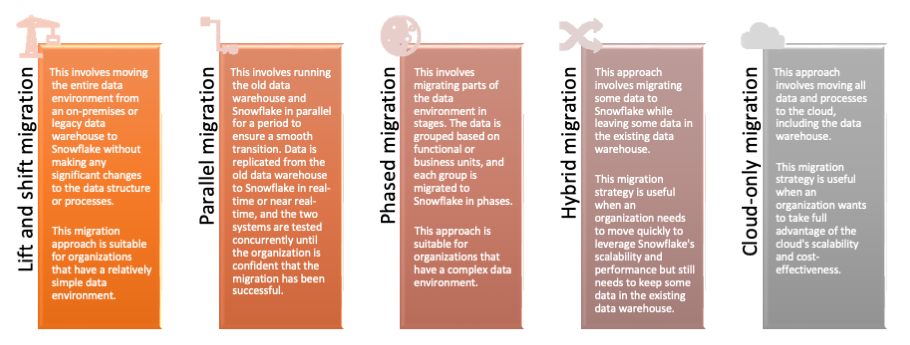
5. Plan for your Snowflake migration
Once you have decided on a migration strategy, the next step is to plan the migration of data, ETL workflows, cutover of applications, etc. Your plan should reflect the following at the very least:
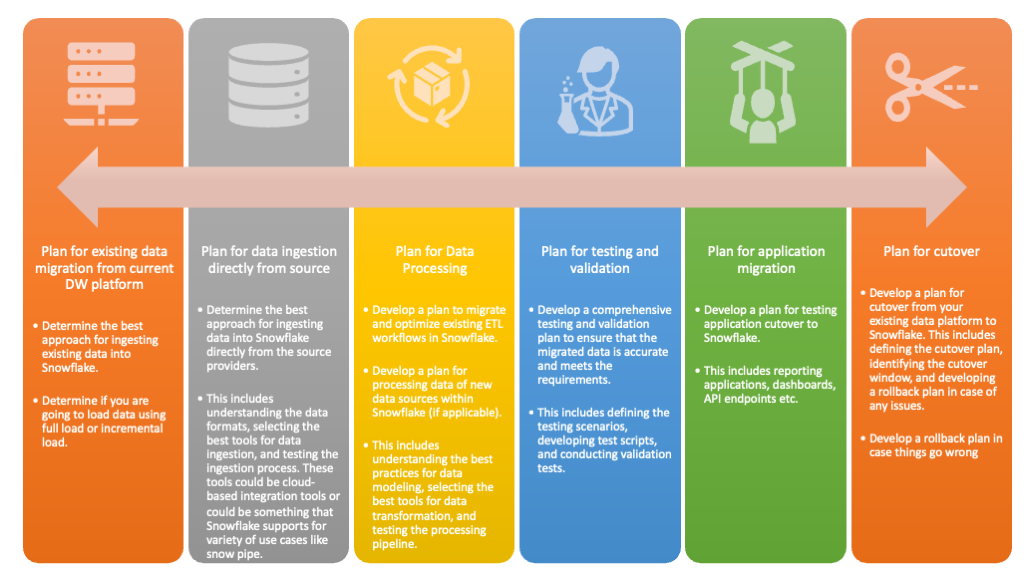
6. Train users
Develop a training plan for users to ensure they understand how to use Snowflake effectively. This includes developing training materials, conducting training sessions and providing ongoing support. Check out Snowflake Education for details on the programs available.
7. Pilot
Now that we have outlined the strategy and proper planning, it’s time to put the plan to the test. We understand that migrating to Snowflake is a significant undertaking, and executing the projects carefully is essential to minimize disruption to your organization’s operations. Which is why the next logical step is a pilot. The pilot phase of the migration involves testing Snowflake in a controlled environment to ensure that it meets your requirements. Here are some steps you might take during the pilot phase:
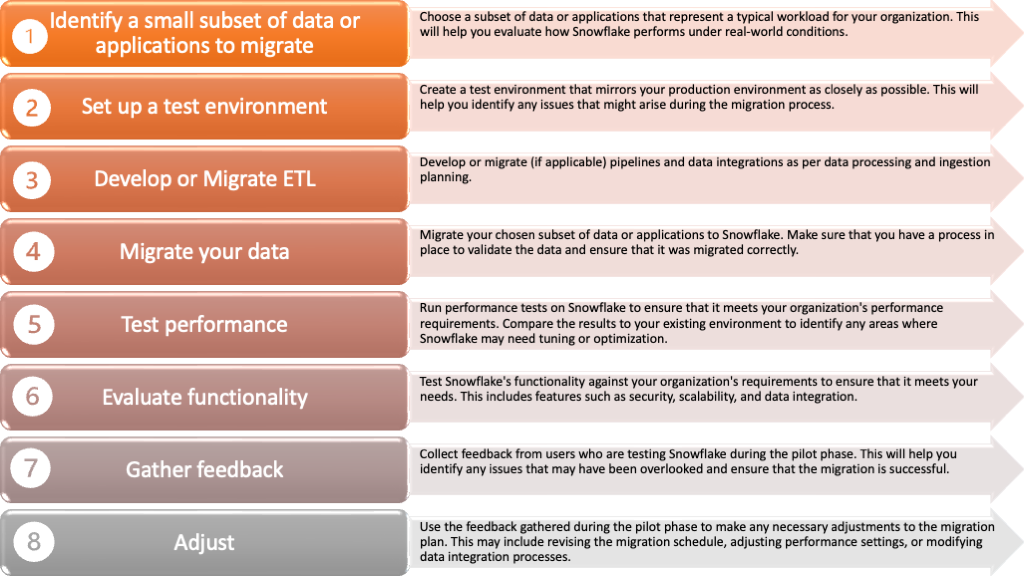
8. Go Live
After a successful pilot phase, you can move forward with the migration to Snowflake. Here are some steps to consider during the migration:
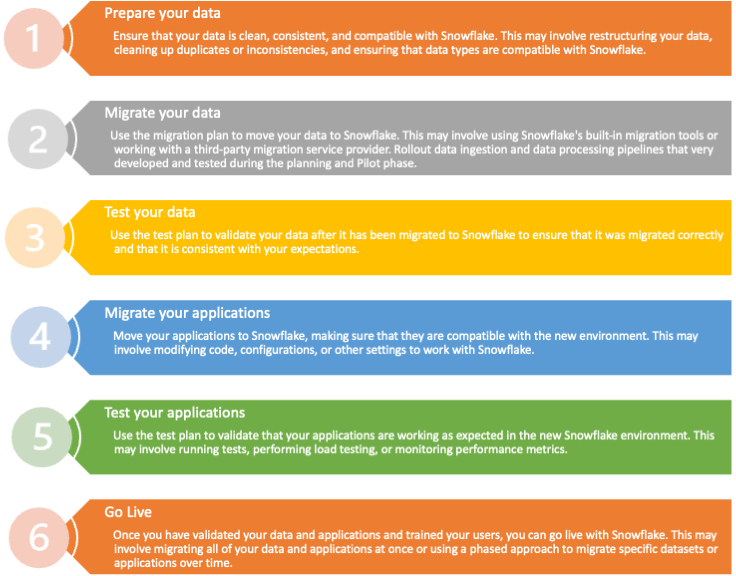
9. Monitor and optimize
Finally, once the migration is complete, it’s essential to monitor the performance of Snowflake and optimize the system for the best performance. This is an ongoing process. This includes monitoring query performance and usage, tuning the data warehouse, optimizing data processing and costs, etc.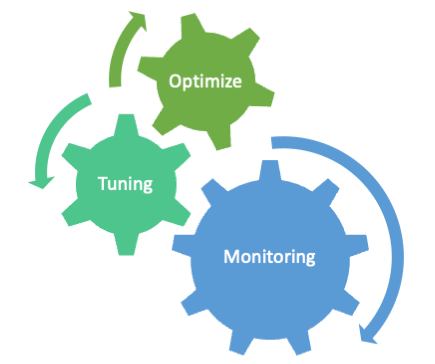
Conclusion
Migrating to Snowflake can be a complex process, but with a well-planned migration checklist, you can ensure a smoother transition. By defining the scope of the migration, evaluating the source system, planning the data migration, planning for integrations and processing, preparing for ongoing operations, testing thoroughly and training your users, you can minimize disruption and maximize the benefits of the new platform.
Planning a migration can be daunting and consume many cycles before any significant success is realized. At Pythian, we have used our expertise and knowledge across data sources, predefined templates, accelerator programs and QuickStart guides to help customers move to Snowflake faster. Whether you’re in the early stages of developing a strategy for migration or working toward mobilizing your workloads on Snowflake, leverage our data experts so your data can be treated with the affection it truly deserves.
Data Migration Services
Ready to migrate your data with confidence?
Share this
Share this
More resources
Learn more about Pythian by reading the following blogs and articles.
Database migration using Apache NiFi
Database migration: how to handle large tables
Speeding-Up Oracle Export/Import Migration
Ready to unlock value from your data?
With Pythian, you can accomplish your data transformation goals and more.
